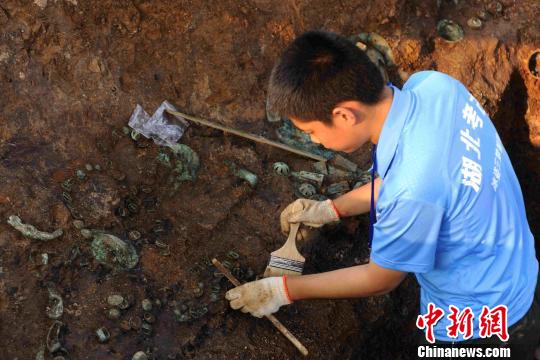 |
A worker excavates ancient wares from earth in central China's Hubei Province.
|
Source: China.org.cn/ Xinhua, July 9, 2013
A painted bronze pot has been unearthed from a cluster of tombs in central China's Hubei Province, marking the first discovery of painted bronze in an a dynasty about 3,000 years ago, archaeologists said Monday.
A painted bronze pot has been unearthed from a cluster of tombs in central China's Hubei Province, marking the first discovery of painted bronze in an a dynasty about 3,000 years ago, archaeologists said Monday.
Researchers are still excavating the Yejiashan Graveyard in the city of Suizhou. The graveyard is believed to have been used to bury the lords of the Zeng State during the early Western Zhou Dynasty (1046-771 BC).
Zhang Changping, a professor at the School of History at Wuhan University, said the discovery of the pot will help researchers better understand changes in aesthetic preference that occurred during the Western Zhou Dynasty.
Over 1,500 bronzes, pottery works and lacquered items have been unearthed from the tombs so far.
Huang Fengchun, director of the archaeology team working at the tombs, said the items will aid in research regarding the chronology of the Western Zhou Dynasty and could serve as important evidence for the study of culture in the Hangjiang River Basin.
The Yejiashan Graveyard was discovered in 2011 and was one of the most important archaeological findings in China that year.
CNTV, July 8, 2013
| In Suizhou in Hubei Province, some new archaeological discoveries have been made in a series of tombs from the West Zhou Dynasty in Yejiashan. (ecns.cn) |
 For a video report, click HERE
For a video report, click HERE
WUHAN, July 4 (Xinhua) -- Sacrificial pits for horses and chime bells have been unearthed from a cluster of tombs in central China, providing insight into a dynasty about 3,000 years ago, archaeologists said.
Researchers are still excavating the Yejiashan Graveyard, in Suizhou City in Hubei Province, believed to have belonged to lords of the Zeng State during the early Western Zhou Dynasty (1046-771 BC).
Seven sacrificial pits have been found with horse skeletons buried inside, the first time horse pits from that period have been found in the southern part of China, said Li Boqian, an archaeologist at Peking University.
Five bronze chime bells have also been unearthed from a newly discovered tomb, said Huang Fengchun, researcher with the Hubei Provincial Institute of Archaeology. The tomb is believed to be the largest in the dynasty, Huang added.
Archaeologists are still excavating the site to find out the chime's full size, hoping that the bells might offer clues on the origin of the musical instrument, Li said.
First discovered in 2011, the Yejiashan Graveyard was inscribed among China's Top 10 Archeological Findings that year. More than 700 pieces of crockery, bronze wares, lacquerwares and jade have been excavated from the tombs.
For more large scale photo's, click HERE


No comments:
Post a Comment